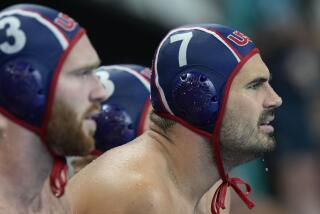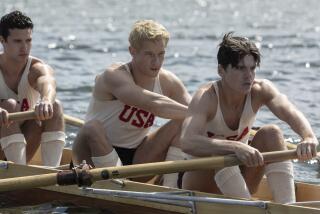D.C. Is the Place to Be When It Comes to Paddling
- Share via
WASHINGTON — It wasn’t easy, but Cathy Hearn was doing her best to explain to a puzzled newcomer how she manages to stay among the top whitewater kayakers in the world, even though she’s moved from the suburbs of Washington to rural Connecticut.
“Look,” she finally said in gentle exasperation, “D.C. is the center of the paddling universe, okay? But it isn’t the paddling universe.”
Or maybe you didn’t know that here among the monuments in shining marble, the stately boulevards, the oppressive summer heat and the mile-high stacks of bureaucratic paper, a world-class sporting dynasty lurks.
If you didn’t, you’ll find out over this weekend and next as the cream of international whitewater racing competes in the first world paddling championships ever held in the United States.
Six hundred slalom and wildwater canoeists and kayakers from 25 nations are now convened at the rumbling Savage River, a Potomac tributary in Western Maryland, for racing that begins Saturday. Few among them failed to make a stop in Washington along the way to pay tribute to some of the best in the game.
It’s been 10 years now since Hearn, 31, her brother Davey, 30, and suburban Washington neighbors Jon Lugbill and Bob Robison rocked the whitewater world with a dazzling display of boating virtuosity at the 1979 worlds in Jonquiere, Quebec.
When it was over, Americans were uncontested champions of the paddling world. Lugbill, Davey Hearn and Robison swept the top three places in slalom canoe, an event no American ever had won before, and Cathy Hearn took three of the four gold medals in women’s kayak, which no American had won before, either.
In the decade since, Americans in general and Washingtonians in particular have set the pace in the fast-changing sport of whitewater slalom, which in 1992 rejoins the Olympics for the first time in 20 years.
Since 1979, for example, Lugbill and Davey Hearn have finished one-two in every slalom canoe championship, Lugbill taking four of the five golds in such far-flung places as Bourg St. Maurice, France; Bala, Wales; and Merano, Italy, to become the top slalom canoeist of all time.
Meantime, lured by U.S. successes, top racers from England, Australia, France, Italy, New Zealand and elsewhere have migrated to train for weeks and months with Washington’s elite on a Potomac River practice course just below Little Falls, not 10 miles from the White House.
Now come the worlds as partial reward. “The International Canoe Federation let us know they would look favorably on an American bid after we did so well again in 1983,” said U.S. slalom team coach Bill Endicott.
To understand the origins of Washington’s whitewater phenomenon, it helps to know a bit about the nation’s capital, its remarkable river and the highly motivated people it attracts.
Endicott, for example, moved to town in the mid-1970s, fresh from a graduate degree at Harvard, with an ambition to fix some of the nation’s social ills. He worked a while as a congressman’s aide, then on the prestigious Democratic Study Group.
But as an ex-whitewater paddler and Harvard oarsman, he couldn’t help noticing the beautiful river cascading through his adopted city. Before long, he was out playing on Potomac whitewater.
There he ran into Lugbill, the Hearns and a host of other local youngsters, all fired up about racing after Silver Spring, Md.’s Jamie McEwan won a bronze medal in slalom canoe in the 1972 Olympics, the only previous Olympics ever to feature the arcane sport. When the youngsters asked Endicott to coach them, he agreed.
Within a few years, Endicott had quit his career to devote full time to coaching, living off a modest trust fund and spending mornings and evenings hounding his charges up and down the Potomac with a stopwatch.
“Bill wound up the perfect coach,” said Cathy Hearn. “He provided organization, objectivity and helped the overall attitude of the group, but he didn’t try to tell us what to do.
“But the most valuable thing,” she said, “was that he was a tireless, fanatical worker. Here was this volunteer killing himself for us. What were we going to do in return for him? The feeling was, we’d better deliver.”
And they did. In 1977, Robison, then 15, was fourth in slalom canoe at the world championships in Spittall, Austria. The Washington-based, two-man canoe team of Steve and Mike Garvis also took fourth and Cathy Hearn won a bronze medal in the women’s kayak team race.
That should have been fair warning to the world, but no one, not even the Americans, was prepared for the 1979 tour de force, which signaled the start of U.S. domination in a sport practically no one in the nation had even competed in before 1957.
By 1981, decked canoes designed by Lugbill, Robison and Davey Hearn were the standard for the world, as they are today, and slalom paddling and boat-handling techniques the trio devised were miles ahead of anyone else’s, as they also remain.
“I was 18 years old when I won the world championship for the first time,” said Lugbill, shaking his head in wonder during a lunch-hour break from his job as Potomac River water quality analyst for the metropolitan Washington Council of Governments. “That’s amazing.”
Far more remarkable is the fact he remains world champion a decade later, with no one on the horizon except perennial Washington, D.C., rival Hearn and recent Washington transplant Jed Prentice even remotely likely to overtake him.
Washingtonians have redefined whitewater slalom canoeing. To understand how requires a little background on the sport itself.
Whitewater river-running underwent a sea change in the early 1960s with the advent of fiberglass boats. Before then, runs through rapids were hair-raising affairs in heavy, open, aluminum or wooden boats or folding, canvas-covered kayaks that needed patching after every run.
Plastic provided a light, durable, cheap, easily repairable alternative. Suddenly, rampaging rivers that had been the province of daredevils and fools were approachable by the masses.
A busy racing schedule evolved, with races following two forms. Slalom competitors ran 600-yard courses through 25 gates strung in the toughest places, with penalties if they touched the gatepoles; wildwater racers went five miles or so in a straight shot downriver with no gates, like downhill ski racers.
Both disciplines flowered in Europe, where world whitewater championships had been held since 1949, but developed more slowly in the United States.
McEwan’s charge to Olympic bronze in 1972 changed that. “We were out on a geological expedition that summer,” said Cathy Hearn, “and when we heard the news on the radio, I remember saying, ‘That’s for me.’ ”
Washington, with the largest canoe club in the nation, the 2,000-member Canoe Cruisers Association, was just the place for the movement to take hold. And the new interest in paddling corresponded to a time of dramatically improving river quality as President Lyndon B. Johnson’s mid-1960s pledge to make the Potomac swimmable began taking effect.
The young Hearns found themselves increasingly headed to the river, where they bumped into Lugbill and his brother Ron; Robison; the Garvises; Lecky and Fritz Haller; Chris, Mike and Mark McCormick and a host of other would-be world beaters.
In the rebellious days of the early ‘70s, “Our attitude was whatever had been done in the past, we weren’t going to do,” said Lugbill. “Anything that was status quo we changed.”
Lugbill and Robison became known for their frenetic paddling style, directly contrary to European traditions of smoothness and technique. The pair were comical figures on the river, crashing and flipping and running out of control.
Meantime, Lugbill, Robison and Davey Hearn spent their spare time rubbishing old boat designs in an effort to shape a better hull. Conventional slalom canoes were too big, they decided, so they sawed a smaller kayak in half, expanded it to make it legal canoe size, and laid up a decked canoe in its shape.
The youngsters discovered that the sleeker, smaller boat made it possible to sneak under slalom gates sideways. That was much faster, and as they perfected techniques, Robison accidentally invented the quick “pivot turn” now favored by all slalom racers.
Robison demonstrated his pivot to slack-jawed European competitors at the 1979 worlds. For them, the American nightmare had begun, and old-school European slalom canoeists haven’t fully recovered yet.
To be sure, Europeans will win their share of medals on the Savage. The U.S. grip has slackened as the best American paddlers aged. Cathy Hearn is a long shot, at best, to win a medal this year; after several bouts of shoulder trouble, she’s only the second-best U.S. women’s kayaker behind Dartmouth graduate Dana Chladek, who moved to Washington to train two years ago. David Hearn at 30 is beginning to suffer aches and pains.
The British have a stranglehold on men’s and women’s slalom kayak events, with three-time gold medalist Richard Fox a near lock in the men’s division and countrymate Liz Sharman the favorite on the women’s side.
Americans never have dominated wildwater competition, which remains largely the province of Eastern Europeans, and in fact the United States has not taken overall national honors at the worlds since 1981, although it’s been a strong second each year.
But there will be special advantages for the Americans in having the event in their own backyard, while Soviets, Czechs, Aussies, French and New Zealanders wrestle with the cultural and social discombobulations the Americans long have endured overseas.
But the voyage to Maryland’s most rural county, with just 25,000 inhabitants and millions of trees, should be pleasant enough for foreigners. They’ll enjoy the best whitewater racing stretch in the east.
At night, the visitors may gaze upon a starlit summer sky, its brilliance undiminished by urban haze. And on the way home, they can always stop in Washington for a last glimpse of the paddling universe from the other side.
From the center, looking out.
More to Read
Go beyond the scoreboard
Get the latest on L.A.'s teams in the daily Sports Report newsletter.
You may occasionally receive promotional content from the Los Angeles Times.






